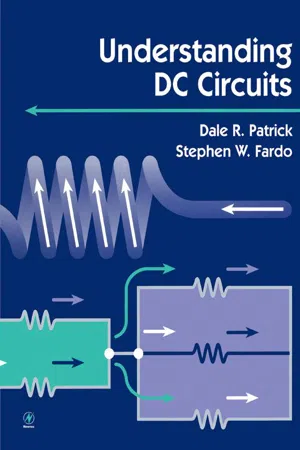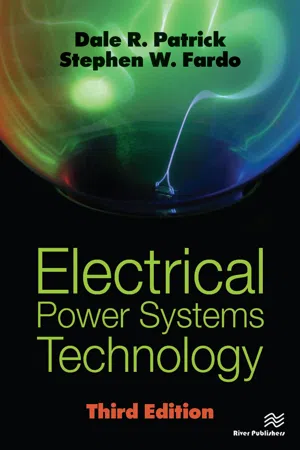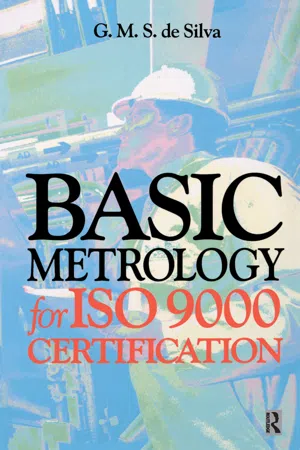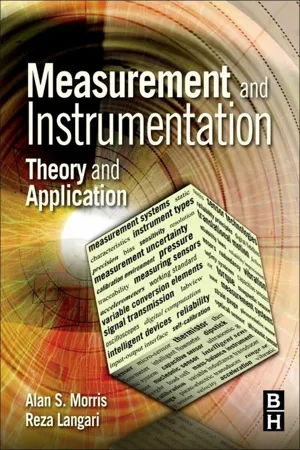Physics
Voltmeter
A voltmeter is an instrument used to measure the voltage or potential difference between two points in an electrical circuit. It typically consists of a sensitive galvanometer connected in parallel with a high resistance, allowing it to measure voltage without significantly affecting the circuit. Voltmeters are essential tools for analyzing and troubleshooting electrical systems.
Written by Perlego with AI-assistance
10 Key excerpts on "Voltmeter"
- eBook - ePub
- Ahmad Hemami(Author)
- 2017(Publication Date)
- CRC Press(Publisher)
Figure 5.4 ). The measured value is the voltage applied to the load. A Voltmeter, in fact, measures the voltage difference between two points.Voltmeter: Electrical instrument to measure electric voltage.Figure 5.3 Use a Voltmeter to measure voltage between two points.Note that, whereas in a single (one loop) circuit there is only one current, there are various voltages depending on the number of components in the circuit and where the measurement is made. For instance, in Figure 5.5 there is a 100 Ω load and two 0.5 Ω wires connecting the load to the 120 V power supply. We may measure the voltage between each pair of points A, B, C, D, and E; for example, A-B, A-D, B-C, B-E, and so on. The measurement across the source shows the source voltage. Note that in Figure 5.5 all the points A to E are selected at a graphically suitable point in the line connecting two elements together. Any other point on each line denotes the same point of the circuit.Figure 5.4 Measurement of voltage across two points.Figure 5.5 There are numerous voltages between various points in any circuit.In DC electricity, voltage measurement shows the polarity, too. So, if the positions of the leads of a meter are swapped, in a digital meter the reading will appear with a negative sign, but in an analog meter the reading cannot be done because the needle is forced to move to the left.A Voltmeter measures the voltage difference between two points by connecting the meter leads to those points.Example 5.6In the circuit shown in Figure 5.6 , measurement of the voltage across R 2 shows a value of 75 V and a measure of the current in the circuit shows a value of 0.68 A. What is the value of the resistor R 2 - eBook - ePub
- Dickon Ross, Doug Lowe(Authors)
- 2013(Publication Date)
- For Dummies(Publisher)
ohmmeter.Like voltage, resistance can also be measured with an ammeter. As we state in the preceding section, a direct relationship exists between voltage, resistance and current in any circuit, and if you know any two of these quantities you can easily calculate the third. So to measure voltage, a Voltmeter provides a fixed resistance, uses an ammeter to measure the current and then uses the resistance and current to calculate the voltage.To measure the resistance of a circuit, an ohmmeter provides a fixed amount of voltage across the circuit, uses an ammeter to measure the current that flows through the circuit and then uses the amount of voltage the meter provides and the amount of current the meter reads to calculate the resistance.As with voltage, you don’t have to do this calculation (phew!); it’s automatically made by digital multimeters and is built in to the meter scale for analogue multimeters. Thus, all you have to do is read the display or the needle on the meter to determine the resistance.A quick look at Ohm’s lawIn Book II, Chapter 2 , you take a close look at resistors and at Ohm’s law, which is one of the most important mathematical relationships in electronics. Here we give you a brief overview without going into all the details.Ohm’s law describes a fundamental relationship between current, voltage and resistance in an electrical circuit. Remember that voltage is the difference in electrical charge between two points, and that if a conductor connects those two points current will flow through the conductor.Other than exotic superconductors (which exist only in laboratory experiments), no conductor is perfect. All conductors have a certain amount of resistance that inhibits the flow of current. The greater this resistance, the less the current will flow. The less this resistance is, the more the current will flow. - eBook - ePub
- Joseph E. Fleckenstein(Author)
- 2017(Publication Date)
- CRC Press(Publisher)
7 Instruments and MetersMost devices used in the electrical industry to measure electrical properties are called “meters.” For example, there are Voltmeters, ammeters, as well as numerous other types of meters. Although most of these devices are truly instruments of some description, the term meter seems to be the more commonly applied term. By common usage, an electrical “meter” is a device that measures and sometimes records an electrical quantity as current, voltage, or resistance.Electrical meters with a wide variety of capabilities are needed for installing, analyzing, and maintaining electrical systems. For example, megohm meters are needed to confirm that the insulation of a new system is adequate before the new installation may be safely energized. Phase sequence meters are used to confirm phase sequence and thereby help ensure proper connections to motors. After installation of an electrical system, ammeters may be required to measure system amperages in various conductors. The monitoring of voltage levels is needed to ascertain that potentials at an installation are within acceptable limits; for that purpose, either multimeters or permanently installed meters are required. Power quality meters can provide a higher level of monitoring of voltages. Wattmeters and power meters are special kinds of meters that allow a provider of electricity to charge for an electrical service.Wattmeters and energy (watt-hour) meters are treated in the following paragraphs and some of the other common types of electrical instruments are reviewed later in this section. 7.1 Power MeasurementsThe measurement of circuit amperage or voltage can be accomplished with meters by an easily understood procedure. Power measurements can be a little more challenging. Whereas single-phase power and energy measurement can be conducted in a straightforward manner, the use of meters on three-phase systems requires greater knowledge and training. Three-phase meters have more connections than single-phase meters, and correct readings can be obtained only if the connections are made in the proper configuration. - eBook - ePub
- Dale R. Patrick, Stephen W. Fardo, Ray E. Richardson, Brian W. Fardo, Mark Barron(Authors)
- 2023(Publication Date)
- River Publishers(Publisher)
Electrical instruments are designed primarily to measure specific electrical values and display this information in a usable manner. Hand-defection meters, digital display instruments, and data logging instruments may be used to perform the measurement function. These instruments may be designed to measure only one specific electrical quantity over a rather narrow range or several different quantities with multiple ranges. Typical electrical quantities that are measured in the evaluation of building equipment are voltage, current, power, resistance, and power factor.The measurement of certain electrical quantities often causes some confusion because of the terminology used. Current, for example, is measured with an ammeter. The fundamental unit of current is the ampere (A). Voltmeters are used to measure electrical voltage. The fundamental measuring unit of voltage is the volt (V). Electrical power is somewhat unusual because it is measured in watts (W). Watt-hours (Wh) is a measure of the power consumed for a given unit of time. Resistance is measured with an ohmmeter. Meters of this type may have the word “ohms” or the Greek letter Omega (Ω) displayed on the scale. Power factor is measured with an instrument that has a scale graduated in values from 0 to 1. A power factor (PF) of 1 is ideal, with decimal values less than 1 being less desirable.Hand-Deflection Instruments
Historically electrical instruments relied upon the movement of an indicating hand or pointer are referred to as hand-deflection instruments. The volt-ohm-milliammeter (VOM) ofFigure 10.24is a typical example of a hand-deflection instrument. This particular instrument is a multifunction, multirange meter. Single-function instruments that employ only one measurement range are also available using the same principle of operation.Figure 10.24 Hand-deflection VOM (Courtesy of The Vector Group Inc., Instrument Div.).The fundamental operation of a hand-deflection instrument is based upon the mechanical action of its meter movement. A simplification of the basic permanent magnet or d’Arsonval meter movement construction is shown inFigure 10.25 - eBook - ePub
- Dale Patrick, Stephen Fardo(Authors)
- 1999(Publication Date)
- Newnes(Publisher)
Unit 2Measuring Voltage, Current, and Resistance
Another important activity in the study of electronics is measurement. Measurements are made in many types of electronic circuits. The proper ways of measuring resistance, voltage, and current should be learned. These are the three most common electric measurements.UNIT OBJECTIVES Upon completing this unit, you will be able to do the following:1. Connect an ammeter in a circuit and measure current.2. Demonstrate how the Voltmeter, ammeter, and ohmmeter are connected to a circuit.3. Measure current, voltage, and resistance of basic electronic circuits.4. Compare calculated and measured values of a circuit.5. Demonstrate safety while making electric measurements.6. Demonstrate proper, safe use of an ohmmeter to measure resistance.Important Terms
Before reading this unit, review the following terms for a basic understanding of terms associated with electronic measurement.Ammeter A meter used to measure current (amperes).Continuity check A test to see whether a circuit is an open or closed path.Multimeter A meter used to measure two or more electric quantities, such as a volt-ohm-milliammeter (VOM), which measures voltage, resistance, and current, or a digital Voltmeter (DVM).Multirange meter A meter that has two or more ranges to measure an electric quantity.Ohmmeter A meter used to measure resistance (ohms).Polarity The direction of an electric potential (– or +) or a magnetic charge (north or south).Schematic A diagram used to show how the components of electric circuits are wired together.Voltmeter A meter used to measure voltage.Volt-ohm-milliammeter (VOM) A multifunction, multirange meter that usually is designed to measure voltage, current, and resistance; also called a multimeter.Measuring Resistance
Many important electric tests may be made by means of measuring resistance. Resistance is opposition to the flow of current in an electric circuit. The current that flows in a circuit depends on the amount of resistance in that circuit. You should learn to measure resistance in an electric circuit by using a meter. - eBook - ePub
- Adrian Waygood(Author)
- 2015(Publication Date)
- Routledge(Publisher)
General Conference of Weights and Measures was held in November 2014. The proposed new definition of the ampere will be based on the numerical value of the elementary charge (i.e. the amount of charge on a single electron), a figure yet to be agreed! So, as far as the ampere is concerned, watch this space!Measuring current, voltage, and resistance
Although we are able to observe the effects of an electric current or voltage, we cannot, of course, ‘see’ the actual current or voltage itself. So, in order to detect and to measure these quantities, together with resistance, we need instruments that will do the ‘seeing’ and ‘measuring’ for us. The three basic instruments used for this purpose are the ammeter, Voltmeter and ohmmeter (Figures 7.2 , 7.3 and 7.4 ):Most of us are very unlikely to use these individual instruments outside a college laboratory. We are far more likely to use a multimeter (Figure 7.5 ), either analogue or digital, which combines the functions of these three separate instruments into one .Figure 7.5In this chapter, though, we’ll first consider the separate functions of a multimeter. We’ll start by learning how analogue instruments work and how to use them, as they are significantly more complicated to prepare and use. If we can handle an analogue instrument, then we will have no difficulty transferring these skills to a digital instrument.Analogue instruments
Measuring current
Before connecting an ammeter into a circuit, we must always start by de-energizing that circuit with its load-breaking device, such as a circuit breaker.To measure current, we must disconnect the circuit at the point where we wish to measure that current and, then, insert the ammeter at that point. In other words, an ammeter must be connected in series with the circuit under test, as illustrated in Figure 7.6 (where R - Dale R. Patrick, Stephen W. Fardo(Authors)
- 2020(Publication Date)
- River Publishers(Publisher)
Usually, a specific quantity is monitored, either periodically or continuously. Therefore, some type of visual indication of the quantity being monitored must be available. For this purpose, several types of instruments for measuring electrical and physical quantities are available. The basic types of measurement systems can be classified as: (1) analog instruments, (2) comparative instruments, (3) cathode ray tube (CRT) display instruments, (4) numerical-readout instruments, and (5) chart-recording instruments. Analog Instruments Instruments that rely upon the motion of a hand or pointer are referred to as analog instruments. The volt-ohm-milliammeter (vom) is one type of analog instrument. The vom is a multifunction, multirange meter. Single-function analog meters can also be used to measure electrical or physical quantities. The basic part of an electrical analog meter is called the meter movement and is shown in Figure 3-1. The movement of the pointer along a calibrated scale is used to indicate an electrical or physical quantity. For example, physical quantities such as air flow or fluid pressure can be monitored by analog meters. Figure 3-1. Moving-coil meter movement for analog meters (Courtesy Triplett Corp.) Many meters employ an analog movement called the d’Arsonval, or moving-coil, type. The basic operational principle of this type of movement is shown in Figure 3-2. The pointer or needle of the movement remains stationary on the left portion of the calibrated scale until a current flows through the electromagnetic coil that is centrally located within a permanent magnetic field. When current flows through the coil, a reaction between the electromagnetic field of the coil and the stationary, permanent magnetic field develops. This reaction causes the hand (pointer) to deflect toward the right portion of the scale. This basic moving-coil meter movement operates on the same principle as an electric motor- eBook - ePub
- G. M. S. de Silva(Author)
- 2012(Publication Date)
- Routledge(Publisher)
8
Electrical measurementstandards
8.1 Introduction
Measurement of electrical current, potential difference, resistance, capacitance and inductance are of vital importance in industrial processes. A number of different types of electrical measuring instruments such as multimeters, bridges, insulation testers, high voltage meters as well as resistors, capacitors and inductors are in use. A number of other equipment, e.g. electronic balances, load cells and analytical instruments, also use electrically operated transducers or sensors.8.2 SI units
8.2.1 The ampere
The ampere is the SI base unit for electrical current. It is defined as: that constant current which, if maintained in two straight parallel conductors of infinite length, of negligible circular cross section, and placed one metre apart in vacuum, would produce between them a force equal to 2 x I0-7 newton per metre of length.8.2.2 The volt
The volt is the SI unit of electrical potential difference and is defined as:the potential difference between two points of a conducting wire carrying a constant current of I ampere, when the power dissipated between these points is equal to I watt.In terms of mechanical units the volt is:8.2.3 The ohm
The ohm, the unit of electric resistance, is defined as:the electric resistance between two points of a conductor when a constant potential difference of I volt, applied to these points, produces in the conductor a current of I ampere, the conductor not being the seat of any electromotive force.8.2.4 The farad
The farad is the SI unit of capacitance. It is derived from the volt, ampere and second as: The coulomb is the SI unit of electric charge.8.2.5 The henry
The henry is the SI unit of inductance. It is derived from the volt, second and the ampere as: The weber is the SI unit for magnetic flux.The above SI definitions were adopted by the 9th CGPM held in 1948, and are still valid. The realization of the units using physical standards gives rise to numerous practical difficulties. Thus the ampere, the volt, the ohm and other units realized by the BIPM and various national laboratories are quoted with uncertainties arising from inherent limitations of the physical standards and measurement conditions used. - eBook - ePub
- R. Keith Mobley(Author)
- 2001(Publication Date)
- Butterworth-Heinemann(Publisher)
s is specified.At very high frequencies, the current is measured by assessing one of the effects that it produces. Several techniques are possible, e.g. (1) measuring the temperature rise when the current flows through a known resistance or (2) using a Hall-effect probe to measure the electromagnetic field created by the current.17.5 Voltmeters and ammeters
These are manufactured according to several different principles, each being suitable for a particular application. The more common types are discussed briefly below.17.5.1 Moving coil
This consists of a coil mounted between the poles of a permanent magnet. When a current flows through the coil a magnetic field is created and the interaction of this field with that of the magnet produces a torque, proportional to the current in the coil, which causes the coil to rotate against the action of a spring. A pointer is attached to the coil that gives an indication of the magnitude of the coil current (Figure 17.9 ).Figure 17.9 Moving-coil instrumentUnlike most other electrical measuring instruments, the scale is inherently linear. The moving parts of the instrument must be as light in weight and as free from friction as possible in order to preserve accuracy. This implies that the coil is capable of carrying only small currents. If higher currents are to be measured, it is necessary to employ a shunt to divert some of the main current away from the instrument. The arrangement is as shown in Figure 17.10 , where R m is the resistance of the meter and R s that of the shunt. The relationship between the total system current (I ) and that in the instrument (I m - eBook - ePub
Measurement and Instrumentation
Theory and Application
- Alan S. Morris, Reza Langari(Authors)
- 2011(Publication Date)
- Butterworth-Heinemann(Publisher)
Chapter 3 ) that occurs frequently when analogue meters are used. Additional advantages of digital meters are their ability to measure signals of frequency up to 1 MHz and the common inclusion of features such as automatic ranging, which prevents overload and reverse polarity connection, etc.The major part of a digital Voltmeter is the circuitry that converts the analogue voltage being measured into a digital quantity. As the instrument only measures d.c. quantities in its basic mode, another necessary component within it is one that performs a.c.–d.c. conversion and thereby gives it the capacity to measure a.c. signals. After conversion, the voltage value is displayed by means of indicating tubes or a set of solid-state light-emitting diodes. Four-, five-, or even six-figure output displays are used commonly, and although the instrument itself may not be inherently more accurate than some analogue types, this form of display enables measurements to be recorded with much greater accuracy than that obtainable by reading an analogue meter scale.Digital Voltmeters differ mainly in the technique used to affect the analogue-to-digital conversion between the measured analogue voltage and the output digital reading. As a general rule, the more expensive and complicated conversion methods achieve a faster conversion speed. Some common types of DVM are discussed here.7.2.1. Voltage-to-Time Conversion Digital Voltmeter
This is the simplest form of DVM and is a ramp type of instrument. When an unknown voltage signal is applied to input terminals of the instrument, a negative slope ramp waveform is generated internally and compared with the input signal. When the two are equal, a pulse is generated that opens a gate, and at a later point in time a second pulse closes the gate when the negative ramp voltage reaches zero. The length of time between the gate opening and closing is monitored by an electronic counter, which produces a digital display according to the level of the input voltage signal. Its main drawbacks are nonlinearities in the shape of the ramp waveform used and lack of noise rejection; these problems lead to a typical inaccuracy of ± 0.05%. It is relatively inexpensive, however.
Index pages curate the most relevant extracts from our library of academic textbooks. They’ve been created using an in-house natural language model (NLM), each adding context and meaning to key research topics.
Explore more topic indexes
Explore more topic indexes
1 of 6
Explore more topic indexes
1 of 4









